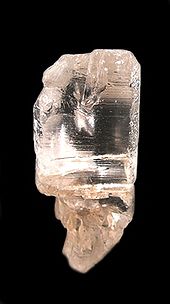Petalite, also known as castorite, is a lithium aluminum phyllosilicate[7] mineral LiAlSi4O10, crystallizing in the monoclinic system. Petalite occurs as colorless, pink, grey, yellow, yellow grey, to white tabular crystals and columnar masses. It occurs in lithium-bearing pegmatites with spodumene, lepidolite, and tourmaline. Petalite is an important ore of lithium, and is converted to spodumene and quartz by heating to ~500 °C and under 3 kbar of pressure in the presence of a dense hydrous alkali borosilicate fluid with a minor carbonate component.[8] Petalite (and secondary spodumene formed from it) is lower in iron than primary spodumene, making it a more useful source of lithium in, e.g., the production of glass. The colorless varieties are often used as gemstones. [citation needed]
Discovery and occurrence

Petalite was discovered in 1800, by Brazilian naturalist and statesman Jose Bonifacio de Andrada e Silva. Type locality: Utö Island, Haninge, Stockholm, Sweden. The name is derived from the Greek word petalon, which means leaf, alluding to its perfect cleavage.[5][9][10]
Economic deposits of petalite are found near Kalgoorlie, Western Australia; Aracuai, Minas Gerais, Brazil; Karibib, Namibia; Manitoba, Canada; and Bikita, Zimbabwe.
The first important economic application for petalite was as a raw material for the glass-ceramic cooking ware CorningWare.[citation needed] It has been used as a raw material for ceramic glazes.
References
- ^ Warr, L.N. (2021). "IMA–CNMNC approved mineral symbols". Mineralogical Magazine. 85 (3): 291–320. Bibcode:2021MinM...85..291W. doi:10.1180/mgm.2021.43. S2CID 235729616.
- ^ "Petalite". Digital Fire. Retrieved 23 October 2011.
- ^ Anthony, John W.; Bideaux, Richard A.; Bladh, Kenneth W.; Nichols, Monte C. (2005). "Petalite" (PDF). Handbook of Mineralogy. Mineral Data Publishing. Retrieved 14 March 2022.
- ^ Webmineral
- ^ a b "Petalite". Mindat.org.
- ^ *Hurlbut, Cornelius S. and Klein, Cornelis, 1985, Manual of Mineralogy, Wiley, 20th ed., pp. 459–460 ISBN 0-471-80580-7
- ^ Nickel, Ernest H.; Nichols, Monte C. "IMA/CNMNC List of Mineral Names" (PDF). Internet Archive. Materials Data, Inc. Retrieved 12 December 2024.
- ^ Deer, W. A. (2004). Framework silicates: silica minerals, feldspathoids and the zeolites (2. ed.). London: Geological Soc. p. 296. ISBN 978-1-86239-144-4.
- ^ D'Andraba (1800). "Des caractères et des propriétés de plusieurs nouveaux minérauxde Suède et de Norwège , avec quelques observations chimiques faites sur ces substances". Journal de Physique, de Chimie, d'Histoire Naturelle, et des Arts. 51: 239.
- ^ Sowerby, James (1811). Exotic mineralogy: Or, Coloured figures of foreign minerals: As a supplement to British mineralogy.
External links
 Media related to Petalite at Wikimedia Commons
Media related to Petalite at Wikimedia Commons- . Encyclopædia Britannica. Vol. 21 (11th ed.). 1911.













